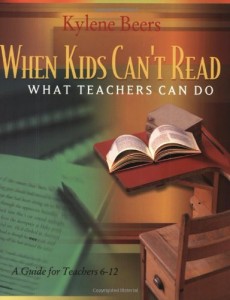When Kids Can’t Read: What Teachers Can Do: A Guide for Teachers 6-12
Author: Kylene Beers
Published: October 22, 2002 by Heinemann Educational Books
Summary: When Kylene Beers entered the classroom in the 1970s, she had dreams of teaching AP classes, filled with students who were passionate, high-level readers. She was shocked when she was confronted by classes of students who not only couldn’t read but didn’t want to read. While she wanted a job teaching seniors in high school, she took the only available position as a seventh grade teacher. George was a boy in her classroom. He couldn’t read. In a conference, his parents asked Beers how she planned to help George, and she didn’t have the answers. After a few years with students like George, Beers set out to find more effective ways to teach students like him.
Review: This practical handbook will prove to be an invaluable guide for both beginning and experienced middle and high school English teachers. I was told by more than one professor that this is the “best book to teach struggling readers.” I expected to learn a few strategies from the book, but I was shocked by just how much I learned. There are so many new ideas, practical tips, and classroom activities that I wish I’d discovered this book much earlier. The book helps teachers diagnose struggling readers’ issues and offers practical solutions.
Teacher’s Tools for Navigation: The book is divided into major sections of: Comprehension, Vocabulary, Fluency, Word Recognition, and Motivation. I don’t believe it is intended to be read cover-to-cover (although I read it that way because I found it to be so fascinating), and teachers can use it as more of a guidebook for diagnosing and addressing concerns with particular students. The inside cover directs teachers to the chapter they might be looking for.
I can’t share all of the awesome details of the book, so I will hone in on one chapter. I’ve always considered myself to be an excellent planner and implementer of pre-reading strategies. I use KWL charts, have students walk around the room to discover concepts, and just adore student debates that stem from anticipation guides. Beers’ book put me to shame. She introduced the idea of a KWGL chart (the G standing for where the students plan to GO for the information). Why didn’t I think of that? Additionally, she presented ideas called the “Probable Passage” and the “Tea Party,” two strategies I had never heard of. In the next chapter about “Constructing Meaning,” she describes ELEVEN (yes, I said eleven) different strategies to engage readers with constructing meaning. I liked the strategies a lot because many of them seemed very fun. I can imagine my students would be extremely engaged in their reading, had I used these strategies. She also provides blank worksheets of the strategies in the appendices (and we love this, don’t we?).
I have read many professional development books. This is certainly one of my favorites because it is practical, easy-to-employ, and extremely useful. I am jealous that I haven’t thought of all of the great strategies, activities, and pointers that Beers has used in her classroom. If I employed more of these ideas, I would feel like the Wonder Woman of the School.
Discussion Questions: What do we do when a student comes tell us they ‘just don’t get it’? What is a struggling reader? Once we’ve discovered that a student can’t read, what can we do about it? How do we create independent readers out of dependent readers? What is the best way to teach vocabulary? How do we help students with fluency and automaticity? Are phonics important? How do we create confidence in our readers?
We Flagged: “I think back to any one of the many days that I encouraged George to ‘just reread it’ and acknowledge that there’s wisdom in that comment, but more important[ly], I recognize the assumption that guided me for a long time: if they read it (the text), it (the meaning) will come. ‘Did you read it?’ I asked. ‘Well, go read it again. You can get it.’ Meaning was obviously something in the text that George could surely grasp if he just read it often enough” (p. 8).
Read This If You Loved: In the Middle by Nancie Atwell, The English Teacher’s Companion by Jim Burke, Readicide by Kelly Gallagher, Deeper Reading by Kelly Gallagher, I Read it but I Don’t Get It by Cris Tovani
What is your favorite book for professional development? Have you read this one? What did you think? Share your thoughts!

